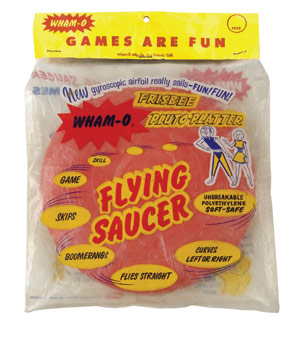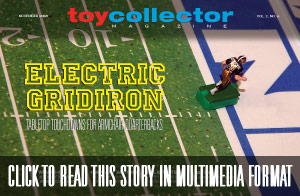
Sixty years ago, two wild and crazy college boys in Southern California launched a slingshot… and, quite by accident, launched a business. Arthur “Spud” Melin and Richard Knerr may not have realized then that a homemade slingshot would be the genesis of one of the most enduring toy companies of all time—the WHAM-O Manufacturing Company.
Their success is notable; their toys—such as Frisbee, Hula Hoop and Super Ball—are iconic. Few toy companies have as long or rich a history, but one thing remains certain—“There’s a lot of nostalgia over their toys,” said Tim Walsh, author of WHAM-O Super Book: Celebrating 60 Years Inside the Fun Factory (Chronicle Books, 2008).
That nostalgia—including his own childhood fondness for WHAM-O toys—prompted Walsh, a game inventor and toy historian, to track down the dynamic duo and dig into company archives for his new book. “I really enjoy giving inventors their due,” Walsh added.
Right on Target
In 1948, eager to start on their entrepreneurial path, Melin and Knerr started making slingshots in Knerr’s parents’ garage. They onomatopoeically dubbed their company “WHAM-O,” after the sound of a projectile hitting a target.
And after reaping initial success through mail order sales, WHAM-O soon expanded not only into a larger space, but into other products as well. The empire of boys’ toys had begun with a bang—enter WHAM-O weapons.
The company’s first foray outside the garage was with weapons. Make no mistake, these weren’t toys, but real weapons with names like the Malayan Throwing Dagger, the Borneo Hunting Blowgun and the Apache Throwing Tomahawk. According to Walsh, “All this weaponry reflected the interests of WHAM-O’s founders.”
Walsh added, “I think parents were more willing to let their kids play with that stuff [then]. Vietnam changed all that. You saw a slow fading out of weapons.”
The objects were dangerous, yet masterfully marketed—with terminology and imagery most would find politically incorrect today.
Targeting the teen boys market, these items provided a somewhat natural transition into WHAM-O’s next line—sporting goods. Boomerangs, jai-alai sets, fencing swords, practice golf balls and tetherball all soon joined the line-up of toys designed to help athletes refine their games. And while some of the products have come and gone, two of WHAM-O’s sporting line—Frisbee and Hacky Sack—have stood the test of time.
“Here’s a company that is really the most prolific outdoor sport company ever,” Walsh said. “They really are the company that inspired kids to get outside and play.”
Flying High, Spinning Free
Already flying high from other sporting toys successes, Frisbee became an eventual best seller and pop culture icon for WHAM-O. But unlike many of the company’s products, the flying disc was not invented by Melin and Knerr. Inventor Fred Morrison brought his Pluto Platter idea to WHAM-O, which licensed the flying disc in 1957 and filed a trademark to rename it “Frisbee” in 1958.
While Frisbee was big, what happened next, in the spring of 1958, would be, arguably, the biggest toy craze the world had seen to date.
While hoops as toys had been around for thousands of years, the Hula Hoop was pure WHAM-O magic. An Australian company had produced the first plastic hoop in 1957 and brought the idea to WHAM-O, who initially called it the Whoopee Hoop.
“We never realized that Hula Hoop was ever going to be as big as it was,” said Knerr, quoted in Walsh’s book.
Walsh added, “Although it’s estimated that the company sold 25 million Hula Hoops that year, it was only about 25 to 35 percent of the total number sold. WHAM-O could have accounted for more, but it just couldn’t keep up with demand.”
At the height of the craze, Walsh said, WHAM-O was making 20,000 Hula Hoops a week, in addition to production it farmed out. And then, almost as quickly as the craze soared, demand for Hula Hoops came swirling to the ground. “In less than a year,” Walsh said, “Hula Hoop had sold faster and then died quicker than any other toy in history, becoming one of the biggest fads ever.”
Boys will be Boys
Many WHAM-O toys appealed to both boys and girls—as well as a fair amount of good-humored adults. But with two fun-loving men at its helm, WHAM-O has always been kingpin in the world of boys’ toys. Wings and wheels provided two prominent themes for WHAM-O in the 1960s. Among its earliest vehicles was the X-15 Space Plane—which was part rocket, part plane and launched—coincidentally enough—like a slingshot.
Next, in 1962, WHAM-O introduced what would be one of its most expensive ($12.95) early toys—the elaborate X-20 Monorail set with track layout and control tower. The more humble AquaJet came next—an ingenious plastic plane that would attach to a garden hose. Water pressure would send the plane soaring in a 12-foot circle.
One of the truly memorable boys’ toys from the 1960s was WHAM-O’s Wheelie-Bar, a bike accessory which allowed riders to “pop wheelies” more effectively and safely, without flipping backwards. It remains a toy sought not only by WHAM-O collectors and bike enthusiasts, but by fans of “Big Daddy” Ed Roth, whose iconic Rat Fink character was used to advertise the product. Because of this cross collectibility, Walsh said the Wheelie-Bar can command $1,000 or more mint in box.
And to feed boys’ interest in guns, WHAM-O reintroduced weapons—albeit toy versions—in the 1960s. The Fun-Gun and Air Blaster guns both shot blasts of air at various targets and, often, at kids’ faces—prompting mothers everywhere to utter that old chestnut: “You’ll shoot your eye out!”
Super Stuff
Melin and Knerr were masterful marketers—making even the most humble toys, such as a rubber ball, seem, well, super. In fact, their penchant for adjectives like “super,” “silly” and “giant” was pervasive in the mid 1960s. Among WHAM-O’s “super” line-up were Super-Stuff (a stretchy gooey compound), Super Sneaky Squirtin Stick (a water toy “masquerading” as a cane), SuperElasticBubblePlastic (blow your own plastic balloons), Super Swooper (a “space age flying device”) and the fascinating SuperBall, which provided more bounce for the buck.
“No one had seen anything like it,” said Walsh of SuperBall, his childhood favorite. The ball was invented by a chemist and brought to WHAM-O in 1964. “To this day, the image of a SuperBall bounding over a suburban home is fixed in the minds of big kids everywhere,” Walsh said, adding that 6 million SuperBalls were reportedly sold in 1965.
Times Change
The toy industry is notoriously fickle. Kids no longer play outside as much as they did in the 1960s with toys like Slip ’n Slide, Frisbee and Water Wiggle. Safety standards have changed, and it’s likely many of WHAM-O’s historical hits would never make it on today’s shelves. And media has changed as well. During their heyday, smaller companies like WHAM-O could effectively pitch their message on TV when there were only three networks, but a similar approach would never work today.
But still, amid being sold several times, WHAM-O remains a viable toy company today, still remaining true to some of Melin and Knerr’s roots by producing sports and activity toys. One key element still remains when reflecting on the WHAM-O name. “Their playfulness,” said Walsh, reflecting on the spirit of the company’s founders.
He added, “Rich and Spud…knew that their greatest asset was the very thing they were creating, selling and promoting…fun.”
WHAM-O MULTIMEDIA: click any image
{rokbox album=|whamo| title=|WHAM-O Frisbee :: In the summer of 1958, while Hula Hoop wowed the world, WHAM-O gave the word “Frisbee” top billing on their multi-named flying disc—the WHAM-O Frisbee Pluto Platter Flying Saucer. Photo courtesy of Tim Walsh from his book WHAM-O Super Book: Celebrating 60 Years Inside the Fun Factory (Chronicle Books, 2008).|}images/stories/2008_11/2008_11_tcm_whamo_01.jpg{/rokbox} {rokbox album=|whamo| title=|Early WHAM-O Weapon Toys :: This 1957 holiday ad pitches some of WHAM-O’s earliest successes—weapons and sports items. Photo courtesy of Tim Walsh from his book WHAM-O Super Book: Celebrating 60 Years Inside the Fun Factory (Chronicle Books, 2008).|}images/stories/2008_11/2008_11_tcm_whamo_02.jpg{/rokbox} {rokbox album=|whamo| title=|WHAM-O Hula-Hoop :: This photo was taken during peak Hula Hoop production in 1958; WHAM-O hired high school and college students to make hoops in summer…and still couldn’t keep up with orders. The bottom image is an advertisement for the popular toy at the height of its craze. Photo courtesy of Tim Walsh from his book WHAM-O Super Book: Celebrating 60 Years Inside the Fun Factory (Chronicle Books, 2008).|}images/stories/2008_11/2008_11_tcm_whamo_03.jpg{/rokbox} {rokbox album=|whamo| title=|WHAM-O Super Ball :: The iconic SuperBall, one of WHAM-O’s most famous and popular offerings. The original ball was introduced in 1965. Photo courtesy of Tim Walsh from his book WHAM-O Super Book: Celebrating 60 Years Inside the Fun Factory (Chronicle Books, 2008).|}images/stories/2008_11/2008_11_tcm_whamo_04.jpg{/rokbox} {rokbox album=|whamo| title=|WHAM-O Wheelie Bar :: A popular character of the day—Rat Fink—is featured on this ad for WHAM-O’s Wheelie-Bar. The device was meant to attach to a bike’s back tire to help the rider “pop wheelies.” Photo courtesy of Tim Walsh from his book WHAM-O Super Book: Celebrating 60 Years Inside the Fun Factory (Chronicle Books, 2008).|}images/stories/2008_11/2008_11_tcm_whamo_05.jpg{/rokbox}



